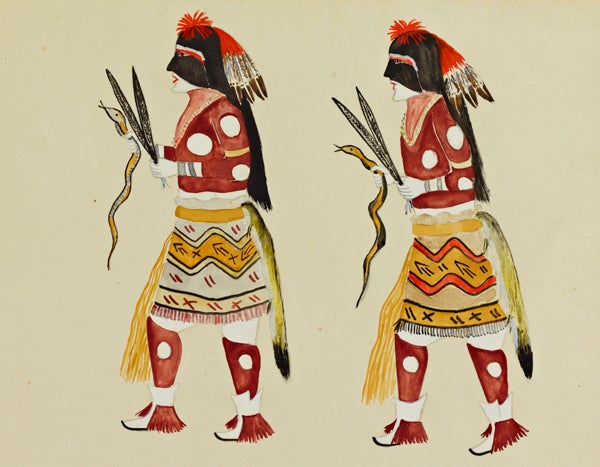|
February 22, 2012
Highlights from Stanford's Native American paintings collection are showcased in Memory and Markets: Pueblo Painting in the Early 20th Century
The works at the Cantor Arts Center celebrate the emergence of Native American painters in the modern art market, beginning in Santa Fe in the 1930s. The paintings will be on view, starting today, through May 27. By Robin Wander

Hopi Snake Dancers, Thomas Vigil (Pan Yo Pin) c. 1930 (Photo: Stanford Museum Collection) In the first decades of the 20th century, a local movement in Santa Fe helped launch the modern school of Native American painting and paved the way toward its recognition in the national art market. The movement started simply with watercolor instruction in living rooms and classrooms and evolved into formalized studio training of generations of painters.
Memory and Markets: Pueblo Painting in the Early 20th Century, at the Cantor Arts Center Feb. 22 through May 27, spotlights an important development in Native American art history. The paintings in the exhibition represent the emergence of Native American painting on paper in the modern art market. Recent gifts from the collection of Malcolm and Karen Whyte and four important loans from the California Academy of Sciences augment highlights from the Center's collection. The exhibition will remain on view through Stanford's 41st annual Powwow in May.
At the turn of the last century, traditional Native American arts such as pottery, jewelry and textiles were common in the Pueblo communities and also in demand in the thriving curio markets positioned alongside the U.S. railroad lines and highways of the American Southwest. But Native American works on paper were rare and not accepted by the national art market.
"Even today, audiences are very familiar with the pottery and jewelry made by the Pueblo Indians of the Southwest, but they are less familiar with their rich traditions of paintings on paper," said Russell Hartman, senior collections manager at the California Academy of Sciences. "This is partly because this tradition did not begin until the early 1900s, and also because Native American painters have long struggled to find their place in Western art and to be considered artists who happen to be Native American, rather than exclusively Native American artists. Until only recently, their works were collected mostly by anthropology museums, and even if a mainstream art museum collected works by Native American artists, they were seldom exhibited alongside the works of non-Indian artists."
Reimagining tradition
Encouraged to record past and current scenes of their daily life on paper, Native American artists in Santa Fe found inspiration in the centuries-old tradition of Pueblo painting seen in pottery, murals and archaeological remains, and developed a new painting style.
"In the first few decades of the 20th century, Pueblo artists began working with watercolors and tempera at the suggestion of local teachers and researchers," said Anna Lessenger, co-curator of Memory and Markets. "The earliest artists were self-taught and struggled for recognition in the local and national art market. In the 1930s, the establishment of a studio at the Santa Fe Indian School formalized the training of generations of painters."
Santa Fe intellectuals, artists and collectors were patrons for the early Pueblo painters; their support aided the artists' crossover from the curio shops to fine art galleries.
The new works were dynamic, colorful and decidedly modern.
Dorothy Dunn, who founded the studio for art education at the Indian school, promoted her students' work so that Pueblo painting would take its "rightful place as one of the fine arts of the world." Exhibitions from the art studio traveled across the United States, including two at Stanford.
Well-known artists such as Tonita Peña and Alfonso Roybal, both from the San Ildefonso Pueblo, are represented in Memory and Markets. Peña was the only woman in the San Ildefonso Self-Taught Group, which included such noted artists as Roybal, Julian Martinez, Abel Sanchez, Crecencio Martinez, and Encarnación Peña. Apache Allan Houser, best known for his modernist sculpture, is also included in the exhibition. Houser started his formal training with Dunn in the 1930s but went on to explore the more realistic style of painters such as Frederic Remington.
Rare opportunity
Due to the delicate nature of works on paper, the 10 Pueblo paintings from the small but distinguished Stanford collection of Native American works will be on display only temporarily. Likewise, environmental conditions at the California Academy of Sciences have not allowed for the display of its Native American paintings, most of which are watercolors that would be damaged by the high light and humidity levels in the public areas.
Works of art on paper are fragile creatures. Paper has a tendency to discolor, crease and tear. Fugitive inks, such as watercolors, fade when exposed to light, and moisture can wreak havoc on pigments. So, when an opportunity arises to see an exhibition of works on paper, it is best to seize the moment because the works are usually on view for only a few months at a time, thereafter returning to storage, often for several years.
Powwow in May
The Stanford Powwow is held every Mother's Day Weekend in the Eucalyptus Grove on the Stanford campus and is sponsored by the Stanford American Indian Organization. This year's dates are May 11–13. "As this year marks the 41st anniversary of the Stanford Powwow, it is great to see that the Powwow continues with its tradition of celebrating all native cultures with the opening of the Memory and Markets at the Cantor," said Stanford student JR Lesansee. "As the only Pueblo student of the Stanford Class of 2014, I think it's great to see that my underrepresented tribe has the chance to showcase its rich cultural tradition of art. I truly believe that this will be a stepping-stone in growing Pueblo representation on campus as well as the Bay Area."
-30-
|